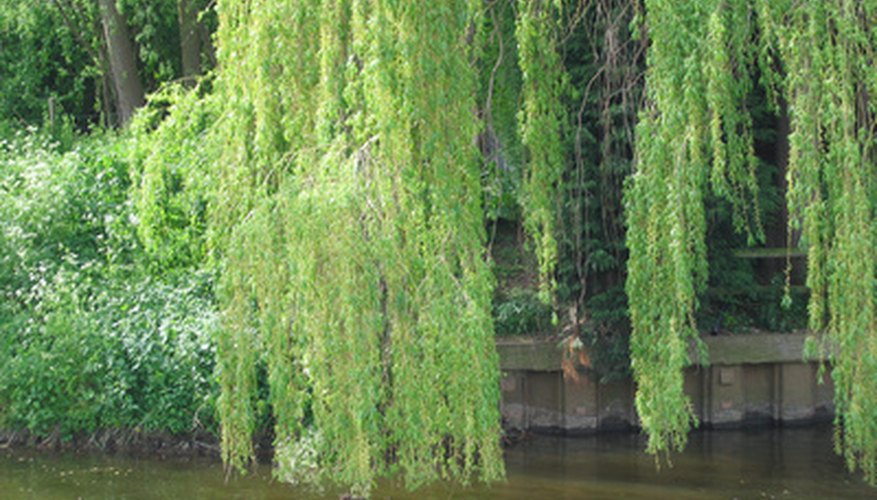The weeping willow tree (botanical name, Salix babylonica) is prized as a graceful specimen plant. Set the willow off on its own---it has a spread of up to 50 feet and a far-reaching root system---and admire the tree's weeping habit, its long, narrow, light-green leaves presenting a shimmery canopy trailing to the ground from a height of 50 feet. If you have a large enough property to accommodate the weeping willow and want it to be a permanent landscape feature, however, consider that it is relatively short-lived.
Fast Growth--Short Lifespan
The weeping willow grows very fast---up to 10 feet per year, until it reaches a height of up to 50 feet. Because of this rapid growth rate, the tree has a relatively short lifespan: 20 to 30 years, according to the University of Tennessee Agricultural Extension Service. To ensure that your willow lives as long as possible, give it a favourable location and meet basic care and maintenance requirements. (Don't worry---the weeping willow is not terribly fussy.)
- The weeping willow grows very fast---up to 10 feet per year, until it reaches a height of up to 50 feet.
Site for Optimum Growth
Native to China, the weeping willow is suited to USDA hardiness zones 4 through 9, although it can tolerate zone 10 if given sufficient water. Some hybrids are suited to zones 2 and 3. It requires full sun and plentiful water. The best sites are on the bank of a creek, lake or pond. Give it plenty of space and do not plant it near underground water or sewer pipes or tanks: its roots will stretch to great lengths in search of water. The weeping willow adapts to most soil types, in pH ranges from 4.5 to 7.5. But make sure the soil is well-drained.
- Native to China, the weeping willow is suited to USDA hardiness zones 4 through 9, although it can tolerate zone 10 if given sufficient water.
- The best sites are on the bank of a creek, lake or pond.
Promote Health and Vigor
Plant your weeping willow at least six weeks before the first frost. According to E. F. Gilman and D. G. Watson of the University of Florida, the tree requires initial pruning and training to develop structural strength. Development of "a strong, central trunk with branch crotches as wide as possible" counters the tree's chronic problem of brittle wood.
- Plant your weeping willow at least six weeks before the first frost.
- Development of "a strong, central trunk with branch crotches as wide as possible" counters the tree's chronic problem of brittle wood.
Fertilise moderately to promote good growth. A strong, vigorous tree is less susceptible to fungal and bacterial diseases, but avoid over-fertilisation. Keep the tree site clear of weeds and rake away fallen leaves, twigs and branches. During summer dry spells, provide water.
Watch for Disease
Several fungal diseases can cause the decline, defoliation or death of a weeping willow. Willow blight is a combination of two fungal diseases--black canker, which appears as greyish or browish sunken area, and willow scab, which causes black or brownish spots on leaves. Infected trees lose leaves, twigs and branches. Check the disease by pruning out infected branches. Rake up and dispose of infected leaves. Howver, should the tree's trunk become girdled by canker, the tree will die.
- Several fungal diseases can cause the decline, defoliation or death of a weeping willow.
- Willow blight is a combination of two fungal diseases--black canker, which appears as greyish or browish sunken area, and willow scab, which causes black or brownish spots on leaves.
Root rot is a fungal disease that can afflict the root system and result in death. The best preventive is good drainage--make sure soil is not compacted. Severe rust, also caused by fungus, can cause defoliation. The application of a fungicide in spring may help control rust. You should rake away and dispose of any rust-infected leaves.
Crown gall is a bacterial disease that causes galls--or swolen areas--on the root crown near the soil line. In some cases, you can cut the gall out--but do so in a dry season and be sure to avoid cutting into healthy tissue. Should galls girdle the tree trunk, the tree will die. Remove the infected tree and avoid replanting on that site for at least 2 years.
Propagate for Extended Lineage
While there's a limit to how long you or your family can keep a particular weeping willow thriving on your property, you can extend the tree's lineage, so to speak, through propagation. Propagate by cuttings; seeds are extremely difficult and slow. Take branches, or "switches," from the tree in spring and place them in a vessel of water. Replenish the water periodically to keep it fresh. Plant the rooted cuttings in the fall.
- While there's a limit to how long you or your family can keep a particular weeping willow thriving on your property, you can extend the tree's lineage, so to speak, through propagation.
- Take branches, or "switches," from the tree in spring and place them in a vessel of water.
